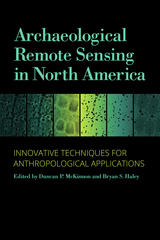Remote Sensing in Archaeology
An Explicitly North American Perspective
Edited by Jay K. Johnson
University of Alabama Press
The coming of age of a technology first developed in the 1950s.
All the money spent by the United States space program is not spent looking at the stars. NASA is composed of a vast and varied network of scientists across the academic spectrum involved in research and development programs that have wide application on planet Earth. Several of the leaders in the field of remote sensing and archaeology were recently brought together for a NASA-funded workshop in Biloxi, Mississippi. The workshop was organized specifically to show these archaeologists and cultural resource managers how close we are to being able to “see” under the dirt in order to know where to excavate before ever putting a shovel in the ground. As the book that resulted from this workshop demonstrates, this fantasy is quickly becoming a reality.
In this volume, eleven archaeologists reveal how the broad application of remote sensing, and especially geophysical techniques, is altering the usual conduct of dirt archaeology. Using case studies that both succeeded and failed, they offer a comprehensive guide to remote sensing techniques on archaeological sites throughout North America. Because this new technology is advancing on a daily basis, the book is accompanied by a CD intended for periodic update that provides additional data and illustrations.
with contributions by: R. Berle Clay, Lawrence B. Conyers, Rinita A. Dalan, Marco Giardino, Thomas J. Green, Michael L. Hargrave, Bryan S. Haley, Jay K. Johnson, Kenneth L. Kvamme, J. J. Lockhart, Lewis Somers
Remote sensing, both aerial and near surface, promises to revolutionize archaeology and cultural resources management, if only archaeologists pay attention to its promises and accomplishments and adopt its techniques. This work should get their attention and convince them of its worth. By far the best introduction to the use of aerial imagery and geophysical techniques available for archaeologists today, it covers the full range of remote sensing from satellite imagery and aerial photographs to near-surface magnetometry, conductivity, resistivity, ground-penetrating radar, and magnetic susceptibility. Missing is light detection and ranging, or LIDAR, probably too new for inclusion. Each chapter that describes one of these techniques provides a clear overview, guidelines for its use, and situations where it might not be effective, and furnishes compelling examples of its application (with additional color illustrations of these applications on the CD-ROM included as an appendix). Other chapters describe cost-benefit calculations, the simultaneous use of several techniques, and the congruence of subsequent excavation with the images and expectations generated by various remote sensing techniques. The conclusion is inescapable: if remote sensing is adopted widely and used intelligently, it will provide the foundations for better archaeology and the means for more effective preservation of historic resources. Summing Up: Highly recommended. All archaeologists and practitioners of cultural resources management.'
—CHOICE
‘Remote sensing has come a long way in recent years, and this book brings together a great deal of useful information. Field archaeologists will find this book very helpful in understanding and evaluating the various methods in use today.’ — Vincas P. Steponaitas, University of North Carolina-Chapel Hill
Remote Sensing in Archaeology, as the full title states, is an explicitly North American perspective. However, wherever you are located on Earth, do not let that dissuade you from reading this book. It is, in fact, a much needed addition to the readily accessible literature on remote sensing techniques in archaeology. . . . This book is an excellent introduction by some of the top specialists in the USA to the use of remote sensing, one that is geared to the consumer rather than the enthusiast or practitioner.' — Archaeological Prospection
Jay K. Johnson is Professor of Anthropology and Director of the Center for Archaeological Research at The University of Mississippi and editor of The Development of Southeastern Archaeology.





